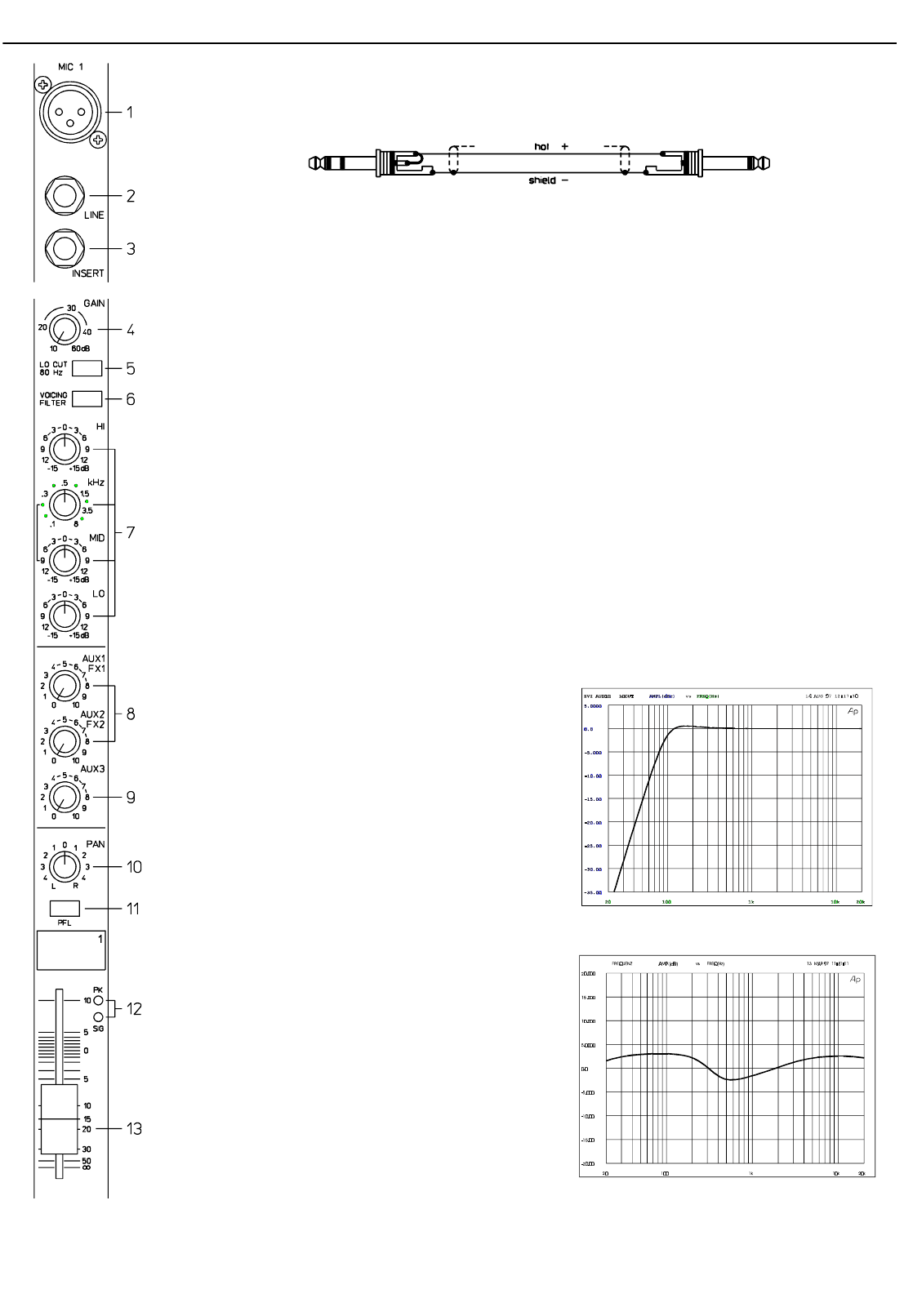
If you want to use this socket as a DIRECT OUT (Pre EQ), the stereo phone plug’s tip and ring have to be short
circuited, so that the audio signal is not interrupted. If you are using a monaural phone plug instead, you will get a
DIRECT OUT with breaker function – the signal flow within the channel is interrupted.
4. GAIN
Rotary control to adjust the MIC/LINE inputs’ sensitivity. These controls let you optimally adjust the incoming signals
to the mixer’s internal operation level. Correct adjustment offers the benefits of improved S/N-ratio and provides
you with the full bandwidth of the PSX’s outstanding sonic capabilities. On the XLR-type connectors, amplification
of +10dB is achieved when the control is set all the way to the left and +60dB when the control is turned all the way
to the right. When dealing with very low input levels, like those that occur during vocal recordings or when the sound
source is located at a distance, the high gain is extremely beneficial. Using the LINE-input, the signal is generally
attenuated by –20 dB. The total adjustment range of 50dB stays the same. The LINE-input’s unity gain – no
amplification (0 dB) – is achieved at the 20dB mark.
The following is meant as a short note for your assistance on how to determine the correct input level:
Note on how to adjust the input level:
1. Set the gain control and the corresponding channel fader to their lowest setting.
2. Connect the desired sound source (microphone, musical instrument, etc.) to the MIC or LINE input.
3. Play the source at its highest volume –sing or speak as loud as possible directly into the microphone or play
the instrument.
4. While you are playing the sound source or singing into the microphone, adjust the input level using the gain
control, so that during the loudest passages the PEAK LED doesn’t blink, but the SIGNAL - LED
lights constantly.
This is the basic channel setting, gives you at least 6dB of headroom, which means you have at least 6dB
before signal clipping. In case you intend to make further adjustments to the channel’s EQ setting, you should
perform the steps 3. and 4. again, since changes in the sound shaping section also influence the channel’s over-
all level.
5. LO CUT 80 Hz
When the LO CUT switch is engaged, frequencies below 80 Hz are attenuated (18 dB-per-octave). In most cases
using the LO CUT filter with microphone channels is a good advice, since it efficiently suppresses popping sounds
and rumbling noise. The only exceptions are kick drum and
acoustic bass.
Sometimes it can be also very effective to combine the LO
CUT filter with the VOICING filter. For instance to provide a
“thin” voice with more “body”, without getting additional low-
pitched noise. Whenever the LO CUT is engaged, raising the
bass level (LO EQ) provides you with a richer sound, but
without additional rumbling or popping noise.
Another welcome side effect is, that the power amplifier and
the connected loudspeakers do not get “polluted” with unne-
cessary low-pitched noise. And the audience will be thankful
for the use of the LO CUT filter, too, since they can enjoy a
truly clear, natural, and powerful sound performance.
6. VOICING FILTER
This button activates an asymmetric microphone filter, which
can be used in addition to the channel EQ. The VOICING
filter enhances the first harmonics of the human voice and
slightly attenuates the mid frequency range. This voice sha-
ping method provides precisely audible, intelligible, and po-
werful vocals that are clearly emphasized from the rest of the
mix and is not achievable using ordinary third or octave
equalizers.
The use of this filter is not restricted to vocals only. Horns,
woodwinds, and other acoustic instruments can also profit
from the voicing filter.
We leave it entirely up to your creativity to try the filter with
as many different sound sources as you like. Normally, you
do not have to worry about the occurrence of feedback.
DIRECT OUT
INPUT/MONO
5of32


















